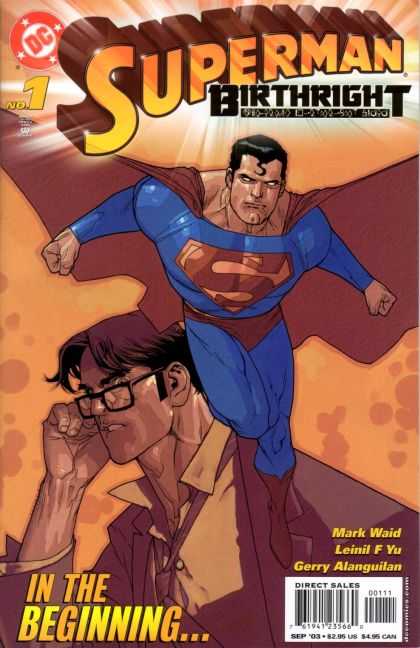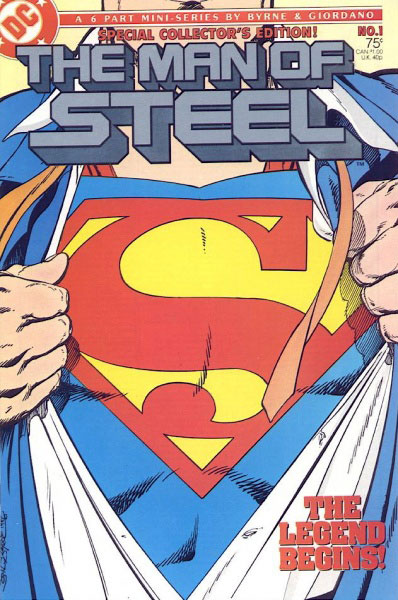|
|
 |
Historiography is about the context of history. It’s about how history is written and how it matters and is interpreted. For example, looking at Superman Birthright, the mini-series written by Mark Waid that redefined the origin of Superman in the new millennium, one can call the narrative groundbreaking, new, original or redefining. But making such comments about Superman Birthright without understanding what it negates from Superman’s history is as important.
Superman Birthright was written by a writer known for his vast knowledge of DC Comics’ continuity and trivia. Mark Waid was the writer picked to rewrite the origins of many DC Comics characters in the 52 maxi-series published in 2006 and 2007. But Mark Waid is also one of the great opponents to the Superman that was created by John Byrne in 1986 which changed the character.
When Byrne was asked to rethink Superman, following the Crisis of Infinite Worlds maxi-series, he removed several layers and years of continuity from Superman’s core and reduced the character’s powers. He also made Clark Kent more than the convenient doppelganger of Superman. Gone was the weakling nerd that could not get the girl. Clark Kent became as interesting as a character as his alter ego Superman. But Superman was alone. He no longer had a cousin with similar powers. He also had his parents back, alive and well. He was no longer split between Lana Lang and Lois Lane. He loved Lois Lane only. Superman was no longer able to juggle planets. He no longer had a bottle city full of Kryptonians with similar powers to his. And worse of all for many, he no longer had a pet dog with similar powers.
Waid’s interpretation of Superman was as much a reaction and an attempt to bring back layers of Superman continuity and elements that Byrne had thought superfluous. Waid represented a school of thought about DC Comics, where all the trivia and weirdness of the comic books of the past was celebrated, incorporated and reused in current stories. It produced a familiar language about Superman that was easily identifiable by a core of Superman enthusiasts.
Yet, no matter how much from Superman’s past was reincorporated into the comic books, when Warner Home Television released a direct to DVD Superman film where he fought Doomsday, in 2007 that Superman owed much to Byrne’s simplified canvas. Luthor was still a business Mogul. Some of Superman’s parents were still alive. Clark Kent was as much a character as Superman. And, there were no bottled city of Kandor, or flying super dogs.
There is a school of thought at DC Comics, represented by writers such as Mark Waid that values the exuberant and contrite history of the publisher’s comic books. There is another school of thought that prefers streamlining DC Comics’ properties and allow as many readers to get on board and enjoy the properties with a fresh outlook.
Crisis in the Infinite Worlds, a series designed to clean the DC Comics universe was one of the early manifestation of this school of revisionism and streamlining. Infinite Crisis was an attempt to validate the rich history of DC Comics and use as much parts of publisher’s history as possible. For example, the continuous revival of characters through legacy characters, the return of the weirdest aspects of that universe, such as the Batman of world or Bat-mite. All of these are valued and expanded upon.
 |
What many readers perceive as the mess that DC Comics has become in 2008 is but the ultimate expression of the two schools of thoughts, fighting for dominance. While DC Comics executive Dan Didio wants to streamline the publisher, for new audiences, he is faced with the constraints of maintaining an unimaginable amount of trademarks of various characters. Because of the difficulty of his endeavour, he must still please a core of readers by adding value to their collections and shared knowledge of DC Comics’ lore. He’s a man trapped between two schools. So when DC Comics seems to a casual observer or even a pundit, as a ship without a captain, it is quite the opposite. DC Comics’ problem is that it may have more than one captain trying to steer the ship in different waters. More on that later.
© Copyright 2002-2021 by Toon Doctor Inc. - All rights Reserved. All other texts, images, characters and trademarks are copyright their respective owners. Use of material in this document (including reproduction, modification, distribution, electronic transmission or republication) without prior written permission is strictly prohibited.

